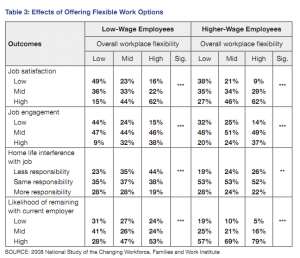Employers may not know as much about work-life flexibility as they think, according to a report from the Families and Work Institute and the Society for Human Resource Management.
This study, Workplace Flexibility in the United States: A Status Report, bashes five assumptions squarely on their noggin.
Assumption #1: Employees who have flexibility will take advantage of it.
Reality: Of those who can make short-notice schedule changes, 70 percent do so once a month or less. There’s no difference in use between low-wage earners and higher-paid professionals.
Assumption #2: Small employers are less flexible because it costs too much.
Reality: Small employers don’t cite cost or small population size as a barrier to offering workplace flexibility. While small employers are less likely to offer formal policies that allow employees control over the shifts they work or the option of moving between part-time to full-time status while staying in the same role or level, their employees report greater access to these options the smaller the organization is.
Assumption #3: Offering flexibility to low-wage earners isn’t worth the investment.
Reality: Employers who offer flexibility to low-wage earners see an ROI of increased engagement, less distraction from home responsibilities, and lower turnover (click chart to view larger image below).
 Assumption #4: Managers see flexibility as a favor for individuals.
Assumption #4: Managers see flexibility as a favor for individuals.
Reality: Human Resources believes their managers consider workplace flexibility a strategic business tool.
Assumption #5: Flexibility is wasted on employees in high turnover industries such as retail, hospitality, restaurant and tourism.
Reality: More employees in these high-turnover industries aren’t planning to move on any time soon. Workplace flexibility translates into money saved in recruiting and training costs and money earned via greater engagement and loyalty.
Bottom line comments: there’s a shifting landscape, with younger generations placing a greater priority on work-life flexibility and older “sandwich” generations requiring it.
The percentage of adult children providing some type of caregiving assistance to a parent has tripled over the past 15 years, which means day jobs morph into night jobs. The greater fluidity between home and work responsibilities that workplace flexibility supports makes it possible for employees to better cope with the competing demands, or desires, from both spaces.
This was originally published on Fran Melmed’s Free-Range Communication blog.
